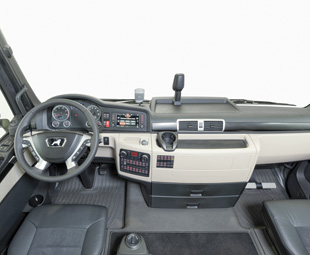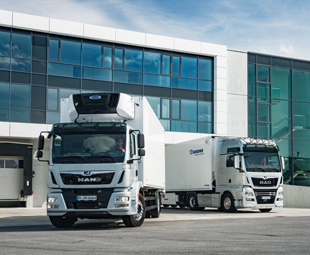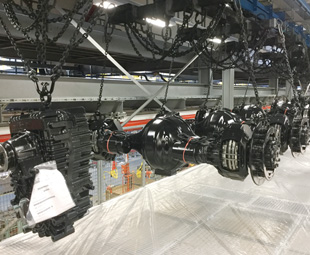MAN pushing European comeback

Jarlath Sweeney, from Fleet Transport, reports that MAN Truck & Bus had a good story to tell at the IAA CV Show in Hannover, Germany, in September
After undergoing restructuring at management, sales and communication levels during the past few years, the Munich-headquartered brand has been born again with investments in research and development beginning to bear fruit. Sales are up 16 percent across Europe, and MAN is chasing Mercedes-Benz hard for the number-one spot in its home country. Its order book is looking good, too.
At the IAA the MY2017 featured a refreshed truck range with cab modifications and upgrades to its engine and driveline, with a great deal of focus on telematics. The flagship TGX has next-generation EfficientLine3, while the TGE van range is totally new.
Joachim Drees, CEO, MAN SE, addressed the press at the company’s Truck Forum event in Munich a few weeks earlier. He began with an outline of its PACE 2017 FutureLine strategy, which will be mainly market and product focused initially, with the objective to push volumes to 125 000 units and to extend its business model from now to 2026.
Customer services will also be in the forefront along with the arrival of its new TGE van range. The TGE is MAN’s new 3,5 to 5,5-t van range based on the new Crafter. The two-year TGE project will be supplied by Volkswagen Commercial Vehicles and built in Poland.MAN will also be concentrating on become a leading component supplier, with an emphasis on its axle production facility.
 Heinz-Jürgen Low, head of Sales and Services at MAN Truck & Bus, mentioned that the second quarter of 2016 recorded “good performance, with a stable order intake, resulting in an eight-percent increase in sales”. Socio-economic issues and political unrest in South Africa, Turkey and Brazil is raising concerns for sales teams in these regions.
Heinz-Jürgen Low, head of Sales and Services at MAN Truck & Bus, mentioned that the second quarter of 2016 recorded “good performance, with a stable order intake, resulting in an eight-percent increase in sales”. Socio-economic issues and political unrest in South Africa, Turkey and Brazil is raising concerns for sales teams in these regions.
Low then highlighted the various enhancements made to the truck range, introduced at the IAA CV Show. He covered the merits of the latest TGX flagship model – from its fresh appearance to “future-proof” modifications and the drivetrain.
“The MAN Lion impresses with a striking exterior look,” he began. “The TGX and TGS receive visually reworked and dynamic cooling air ducts. The interior of all TG models is characterised by a warm colour scheme, with new fabrics and seat covers creating a bright and high-quality image that is perfectly rounded off by the concise design of the steering wheel.”
The figurehead of the brand’s identity, the MAN Lion, which featured in chrome to date, is now more prominent against the new high-gloss black background.
The grille areas have been reworked to become more aerodynamic, yet offering more air inlets for additional air cooling. On the TGX, two horizontal chrome bars differentiate the MY2017 from its predecessors. Automatic running lights will also create an impact.
New interior colour schemes and new fabrics elevate the MAN TGX and TGS to a higher quality level, with two-tone beige and black blending in well with each other in the dash area and around the cabin to the bunks, curtains and door panels. Another significant change is the new, smaller steering wheel. As these models previously had the largest steering wheel in the sector, this is a welcome change.
 Adding to the appeal of the 2017 models is the new MMT MAN Media Truck Advanced Infotainment system; available with a five or seven-inch screen option, with a wide range of convenient connectivity.
Adding to the appeal of the 2017 models is the new MMT MAN Media Truck Advanced Infotainment system; available with a five or seven-inch screen option, with a wide range of convenient connectivity.
This platform includes a broad selection of business solutions through telematics, via a cloud-based system. Fleets will be its main target, according to Frank Tinschert, vice president, Telematics and Digital Solutions at MAN.
Behind the new grille is the latest Euro-6 drivetrain, with increased power, performance and economy. New-generation D38 engines now peak at 477 kW (640 hp) and 3 000 Nm, with the power output from the D26 ranging from 313 to 373 kW (420 to 500 hp) mated to even finer-tuned automated transmissions.
Low said that, with the extra horsepower, a return to the Scandinavian market at this level is evident. The addition of its Eco-Roll free-wheeling motion programme, called EfficientRoll, brings MAN in line with competitors offering this fuel-saving measure.
When introducing the MAN TGX EfficientLine 3, Low chronicled the successful history of the original and its sequel, where impressive reductions in fuel consumption were achieved. “EL3 goes further with an additional five-percent savings on fuel consumption,” he stated.
In Hannover, new concepts for electro-mobility included new digital services that will assist clients to optimise their logistics processes and improve the efficiency of controlling the flow of goods, via intelligent networking, according to Low.
Within this approach is a focus on e-mobility that will lead to the “road to zero emissions” for MAN Truck & Bus, which will cater primarily for deliveries and applications in urban areas.
Expertise in axle production
Established in 1955, MAN’s axle production factory is a short drive from the Truck Forum facility in Munich. At the factory, around 650 employees produce up to
110 000 drive axles per year.
 The drive axles and transfer cases made here supply MAN Group truck and bus plants worldwide, as well as competitor brands such as Mercedes-Benz, VanHool, Temsa and New Flyer (North America).
The drive axles and transfer cases made here supply MAN Group truck and bus plants worldwide, as well as competitor brands such as Mercedes-Benz, VanHool, Temsa and New Flyer (North America).
Two main types of drive axles are produced: hypoid and planetary. Of modular design, hypoid axles are mainly used in distribution and long-haul transport, as well as for buses and coaches.
Planetary axles differ with the addition of transmission ratios within the wheel component as well as a smaller centre drive. They are mainly assembled with drum brakes as the vehicle application covers heavy-duty, off-road operations.
Raw materials are sourced locally or from other MAN facilities, while axle and gearbox housings are produced by specialised external foundries. Around 200 individual components are processed at this vast site, covering 40 000 m2.
With a few exceptions, employees assemble all rear axles on one production line as per customer specifications.
A second assembly line is dedicated to special and front axles. The axle assembly output is controlled using the number and duration of shifts and the cycle time. Production output can be variably controlled.
Impressively, the axle housings are clamped onto automated guided vehicles (AGV), from which the axles are installed as part of flow assembly. A swivelling unit enables different assembly positions to move the axle into the most ergonomically adapted and convenient position for employees.
The driverless transport vehicles are equipped with independent controls, so they can communicate with each other as well as with assembly systems. For instance, the system prevents collisions by reducing the speed of the following AGV in the event that a vehicle ahead has come to a standstill.
Quality assurance is paramount in axle production. “All employees at the assembly line record their processing step in the axle approval record. It represents an elementary component of quality assurance and records process data. Cutting-edge camera technology together with image processing systems also record processing results on products,” says plant manager, Florian Mayrhofer.
The fully automatic axle-painting unit is located at the end of the assembly line. At this station, the units are painted by five basic and two topcoat paintwork robots. Final customer-specific paintwork is then applied in the truck assembly section.
As regular readers of FOCUS know, this magazine has been appointed an associate member of the International Truck of the Year (IToY)! FOCUS is the sole South African magazine to have joined this prestigious body. One of the advantages of this association is access to exclusive articles, specially written for FOCUS by ITOY jury members. This is one such article.
Published by
Focus on Transport
focusmagsa




 !
From 1 Apri
!
From 1 Apri

 Big news from FOCUS on Transport + Logist
Big news from FOCUS on Transport + Logist





 FUSO: Driving the Future of Mobile Healthc
FUSO: Driving the Future of Mobile Healthc



 A brand
A brand




 Wondering about the maximum legal load for a
Wondering about the maximum legal load for a 
 The MAN hTGX powered by a hydrogen combus
The MAN hTGX powered by a hydrogen combus

 Exciting News for South African Operators
Exciting News for South African Operators
